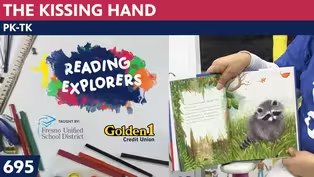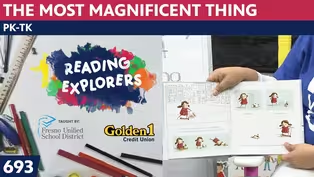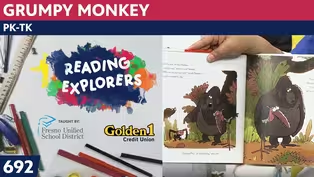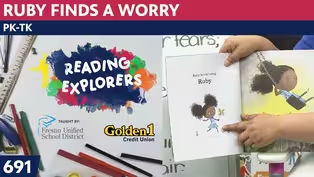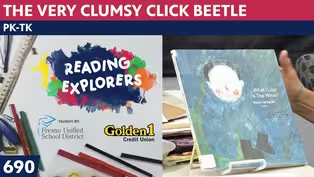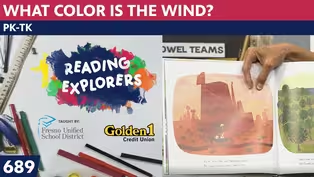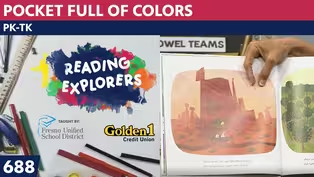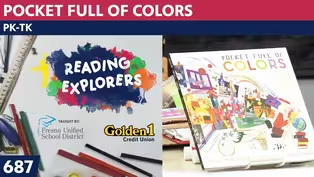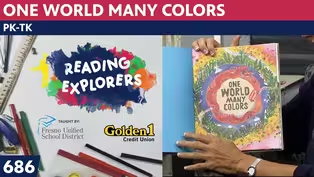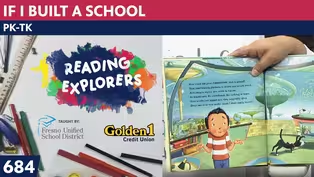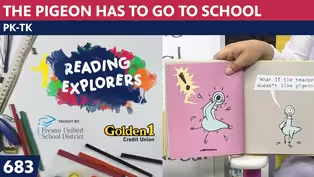
TK-368: Multimedia Pond inspired by Monet
Season 3 Episode 379 | 14m 12sVideo has Closed Captions
Join Mrs. Readwright at Camp Discovery!
Join me today as we continue our Monet Water Lilies study. Each day we will introduce Monet masterpieces that show his interest in the pond on his property in Giverny, France. We will use the painted paper we prepared earlier in the week. We will create several lily pads.
Problems playing video? | Closed Captioning Feedback
Problems playing video? | Closed Captioning Feedback
Reading Explorers is a local public television program presented by Valley PBS

TK-368: Multimedia Pond inspired by Monet
Season 3 Episode 379 | 14m 12sVideo has Closed Captions
Join me today as we continue our Monet Water Lilies study. Each day we will introduce Monet masterpieces that show his interest in the pond on his property in Giverny, France. We will use the painted paper we prepared earlier in the week. We will create several lily pads.
Problems playing video? | Closed Captioning Feedback
How to Watch Reading Explorers
Reading Explorers is available to stream on pbs.org and the free PBS App, available on iPhone, Apple TV, Android TV, Android smartphones, Amazon Fire TV, Amazon Fire Tablet, Roku, Samsung Smart TV, and Vizio.
Providing Support for PBS.org
Learn Moreabout PBS online sponsorshipMore from This Collection
Valley PBS and Fresno Unified School District have partnered with Golden 1 Credit Union to create Reading Explorers Lessons for grades Pre-Kindergarten through Third grade. The daily lessons will be taught by Fresno Unified School District teachers and are created to help students practice their reading skills and reinforce lessons during distance learning.
Video has Closed Captions
Valley PBS presents Reading Explorers Lessons for Pre-Kindergarten and TK. (26m 27s)
PK-TK-693-The Most Magnificent Thing
Video has Closed Captions
Valley PBS presents Reading Explorers Lessons for Pre-Kindergarten and TK. (26m 26s)
Video has Closed Captions
Valley PBS presents Reading Explorers Lessons for Pre-Kindergarten and TK. (26m 28s)
Video has Closed Captions
Valley PBS presents Reading Explorers Lessons for Pre-Kindergarten and TK. (26m 28s)
PK-TK-690: The Very Clumsy Click Beetle
Video has Closed Captions
Valley PBS presents Reading Explorers Lessons for Pre-Kindergarten and TK. (26m 22s)
PK-TK-689: What Color is the Wind?
Video has Closed Captions
Valley PBS presents Reading Explorers Lessons for Pre-Kindergarten and TK. (26m 21s)
PK-TK-688: Pocket Full of Colors
Video has Closed Captions
Valley PBS presents Reading Explorers Lessons for Pre-Kindergarten and TK. (25m 58s)
PK-TK-687: Dancing Through Fields of Colors
Video has Closed Captions
Valley PBS presents Reading Explorers Lessons for Pre-Kindergarten and TK. (26m 20s)
PK-TK-686: One World Many Colors
Video has Closed Captions
Valley PBS presents Reading Explorers Lessons for Pre-Kindergarten and TK. (27m 13s)
PK-TK-685: School is Wherever I am
Video has Closed Captions
Valley PBS presents Reading Explorers Lessons for Pre-Kindergarten and TK. (26m 32s)
PK-TK-684: If I Built a School
Video has Closed Captions
Valley PBS presents Reading Explorers Lessons for Pre-Kindergarten and TK. (26m 21s)
PK-TK-683: The Pigeon Has to Go to School
Video has Closed Captions
Valley PBS presents Reading Explorers Lessons for Pre-Kindergarten and TK. (26m 22s)
Providing Support for PBS.org
Learn Moreabout PBS online sponsorship(guitar music) ♪ Good morning to a brand new day ♪ ♪ Time to learn and games to play ♪ ♪ Learning things is so much fun ♪ ♪ Learning is good for everyone ♪ (playful music) - Hello, early learners.
And welcome back to the art room.
We're doing a water lily study this week.
And we talked about Claude Monet, and how he created his own water lily pond by digging out a huge area on his property, and filling it with water that came from a river.
He dug a trench and the water left the river and would go into his pond and it filled up, and it made the water still.
Once it was there, they closed the hole up to the river, and the river continued on its way, but the pond remained a huge pond.
And he planted the water lilies, and he planted willow trees, and exotic flowers, and different plants and trees.
And you know what else he had there?
He made little homes for white chickens.
He thought white chickens looked beautiful.
It was as if he was building his own painting of real things.
So he had his real pond, and his real trees, and his real flowers.
And he wanted real chickens in there.
And he had pheasants.
And pheasants have these long, beautiful tails.
And he also had other kinds of birds that he enjoyed keeping near his pond.
Let's do our song of greeting the day with "Hello Nice to See You."
Ready?
♪ Hello, nice to see you ♪ (hands clapping) ♪ Everyone ♪ ♪ Hello, nice to see you, everyone ♪ ♪ Hello to you, hello to you ♪ ♪ Hello to you, hello to me ♪ ♪ Hello, nice to see you, everyone ♪ One other thing I was reading about Monet.
Let me get my paper.
And it said that he said his finest masterpiece was his garden.
He had been painting a lot of water lilies.
And in 1911, his wife died, and it made him slow down with his work because he was so sad.
But then finally he got back in his spirit, and he started painting the water lilies again.
And someone commissioned him to paint for a building.
So he started to build, painting more and more water lilies.
And I brought a photograph of a real water lily today for you to see.
Because yesterday, I was trying to describe it and I thought it's kind of a heart shape without the point on the bottom.
It's a heart shape, but without the little point on the bottom, and let's take a look at it.
I have it up here on the blue chart.
And here it is.
You can see here's where it starts like a heart, but it doesn't go to a point, it's round.
And it has its veins that go out.
So, from the center is where this lily flower grows.
So, as it sends its big stem down, and plants in the muddy bottom, it sends the stem up to grow this beautiful water lily.
And when we painted yesterday, I said let's put five.
Because as you keep adding more, and more, and more on our painting yesterday, it would just would have made a big circle.
But you can see, this is cup-like.
It's shaped kind of like a cup.
It has the green that goes around the bottom.
And then the petals unfold kind of like an endive kind of salad you could buy at the grocery store.
But these are kind of dark green, and there are veins all through it.
So, I'm going to be using my green painted paper, and I am going to cut out some water lilies, and painted, sorry, paste them onto my blue painted paper, and make one beginning of a picture that I will add a flower to tomorrow.
So you'll want to have your pink paper painted for tomorrow.
And today we're going to be using the green.
So I'm going to set my things aside.
Boys and girls, you know as you're working on your picture, I really hope that you would send me a picture of you working and send it to the studio.
And we have these books, these activity books that we might send to you if you send your home address to us.
And along with it, you can send a photograph, I would love it.
'Cause I had a picture sent to me by my friend, Frank, over at Fremont Elementary, and it's of a blue jay.
And it gave me such an inspiration.
I keep telling teachers I'm going to do a bird study, and we will do a whole study of birds that I love and see on my bicycle rides.
And there's one that has a little shoulder of red, and I love its song.
I have a book that if you push the button, it will make the sound the bird makes.
So I thought if we made a few bird pictures of birds we can see in the Fresno area.
And when you're out and about, you can carry around your little book, and we're going to make it out of brown paper bags, and you'll have an identification card.
So you can make everyone think, "Oh, this is a birdwatcher."
And you'll say, "Oh, I believe that is the red-wing blackbird."
Or you might say, "Oh, that sounds like the robin."
And you can show people what the birds look like, so they'll be more like science pictures than an art picture.
So I think it's going to be fun.
But Frank, thank you, for sending your picture of your favorite bluebird.
And you'll be getting one of our books in the mail.
And I know how you like mail.
'Cause you told me all about the things that you know and love, which is fun for me.
All right, let's pick up my table, put it on my lap, and see what we have ready to go.
I have my scissors.
I have a bag of white pastels.
Now, you probably wonder, "How did you get all those pastels?"
Well, when I teach art class to children, (coughs) excuse me, boys and girls, I have a little tickle in my throat.
When they get broken and set aside, I just keep them all in one bag, color by color.
But then I have these as well.
These are my set.
And these helped me when I am doing backgrounds to things and they're big.
These I can unpeel and just rub on their sides.
So here's one of my pieces of paper that I painted.
This was my blue piece, and I did the short, horizontal bricks of color, mixing dark blue, turquoise blue, and white.
And it's already to make one pond.
Now, I could just cut out.
Here's my green paper.
I painted one of them.
Just held my sponge and went shoo, held my sponge and went shoo.
This one I painted with a brush and went in a circle.
This one with a brush and a circle, brush and a circle.
I didn't know how many lily pads I'd want to make.
Then I also have this one that I did the texture on, and you can tell what colors I used, green, yellow, and I mixed some blue and green and did that.
And I used a scraper to scrape and make it have some texture on it.
I didn't know how many pieces of green I would want to use.
So I brought two of those ready to go.
But I'm going to show you how I'm going to do this.
Now, on the lily pads that we looked at up here on the chart, you'll see, they have some light and dark, and yellow on the edges.
There's some brown.
So I want to make sure mine looks like an actual lily pad and not just a cartoon one.
Let me set my glue up here so I don't have it fly off the table and roll across the studio.
These won't fly.
But I'm going to do this.
My first job needs to add the reflection of the trees on here.
And remember what we talked about.
The painting is horizontal for water, and vertical for my tree reflection.
So I'm just using my pastel and going down, down, down, down, down to make it look like there's some trees reflecting in the water.
I can leave it as this little sketchy verticals or I brought some tissue to wrap around my finger.
And you can use tissue or you can use paper towel.
And you know how I like to take my fresh clean piece, fold it, get it into like a little pad so that it can wrap it around my finger.
And then I can do this to it, to rub it in.
And they show up pretty bright, I think, on the painting.
I like the way it looks.
And do I like it as well when I rub it in?
I'm not sure about that.
So I'm just going to do this a little bit like this and have my reflection down here.
What I want to do is add some veins to these lily pads I made.
And I made them pretty big, 'cause I wasn't sure how we would want to do it.
So I'm going to add a little yellow around the hole where the lily flower comes up.
I'm going to make the veins using white.
And it goes out and it makes little, like little branches.
So I go out, and make some little branches, out, out, out.
This one, I'm doing white.
And the next one, I think, I might do with some brown.
And I want to add my brown around the edge to make it seem as if it is more shaded, and it has a different little bit of a shape.
So I'm going to go up where it was like a heart like that.
And that way I can make a big water lily.
So I'm mixing it and kind of rubbing it on.
I'm like using my finger actually better than the tissue.
But some people don't like to have the mess on their hands.
I don't mind, I'm just always a messy artist.
So now I'm going to cut it out, and see if it's the right size and shape that I want to use.
And you know, I should show you my tricky way.
Remember I told you, just get close to what you want to cut, so that you don't have to have such big paper.
That's how I suggest to children.
Then it's so much easier to cut things out if you only have a little bit of paper around the edge to get to your shape.
Now, remember when it comes to a place where you have to go in, because you always want to leave your thumb on top and your fingers underneath.
So I'm going to go in and stop.
Then I can go in from this way.
So when I meet that place, I don't have to twist my scissors and twist them in and twist my arm.
'Cause then my scissors go sideways, and I don't want that.
Now, it seems as if my veins are a little too bright.
So what I'm going to do is rub those in a little bit, and you can see.
I'm going to rub and rub, and it makes it blend in a little more.
And maybe I even need to put some of my green pastel on top so it's not quite as bright.
Now, tomorrow when we meet, we're going to put the pink lily on the top of this pad.
So let me get this glued on here so we'll have space ready to go.
I'm just going to put it on here like that.
So I'll get my glue stick for right now.
I might have to use glue, because glue stick doesn't always, when the painted paper is so thick, it doesn't always stick as well as I would like.
But I'm putting it on pretty thick, boys and girls.
And I'll put it on here like this.
And so it can be in the pond, and I'm gonna hold it down as much as I can.
And sometimes I even put a book on top of it so that it will not pop up, but I'm just going to keep my hand here.
Would you count with me?
10, nine, eight, seven, six, five, four, three, two, one.
Hey, pretty good.
So tomorrow when you bring your pink paper, scissors, and glue stick, we will add our lily to this pad.
Let's say goodbye to one another and send us off on the rest of our day.
♪ Goodbye, nice to see you, everyone ♪ ♪ Goodbye, nice to see you, everyone ♪ ♪ Goodbye to you, goodbye to you ♪ ♪ Goodbye to you, goodbye to me ♪ ♪ Goodbye, see you next time, everyone ♪ Thanks for joining me, boys and girls.
(guitar music) ♪ Good morning to a brand new day ♪ ♪ Time to learn and games to play ♪ ♪ Learning things is so much fun ♪ ♪ Learning is good for everyone ♪
Support for PBS provided by:
Reading Explorers is a local public television program presented by Valley PBS
